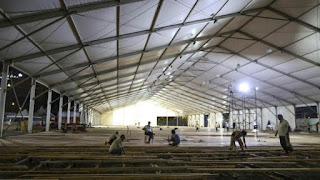Solar Energy
Solar Energy
The Sun gives us energy to survive on Earth. For understanding
this sentence we take a simple example, ‘Trees and plants, convert Sun energy
into fruits by the process of photosynthesis, and these fruits are our food,
which gives us energy to do work’. So, there is no doubt that the Sun energy is
very essential for us. On other side It`s quite interesting to know that, the
energy supply from the Sun is truly enormous, on average the Earth`s surface
receives about 1.2 × 1017 W of solar power. This means that in less
than one hour enough energy is supplied to the Earth to satisfy the entire
energy demand of the human population over the whole year. Indeed, it is the
energy of sunlight assimilated by biological organisms over millions of years
that has made possible the industrial growth as we know it today.
If we look back in history and find discovery about solar energy
then, it was over 150 years when, in 1839, Edmund Becquerel observed that
‘electrical currents arose from certain light- induced chemical reactions’. A
similar effect was observed in a solid (selenium) several decades later. A
comprehensive understanding of these phenomena, however, had to await the
progress of science towards the quantum theory in the early parts of this
century. The development of the first solid- state devices in the late forties
then paved the way to the announcement of a silicon solar cell with 6%
efficiency- this was the first usable solar cell. Solar cells did not have to
wait long to find application. The year 1958 witnessed the launch of Vanguard
1, the first satellite to use electricity from the sun. The technology has been
developing ever since. Much interest in solar electricity appeared particularly
in the wake of the oil crisis in the early seventies. Today, the direct
conversion of light into electricity or photovoltaic is becoming accepted as an
important form of power generation. Over 50 megawatts of photovoltaic power
modules were produced in 1991.
Photovoltaic power generation is reliable, involves no moving parts
and the operation and maintenance costs are very low. The operation of a
photovoltaic system is silent, and creates no atmospheric pollution.
Photovoltaic systems are modular, and can be quickly installed. Power can be
generated where it is required without the need for transmission lines. There
are already a number of terrestrial applications today where photovoltaic
provides a viable means of power generation. Many of these installations
operate in locations where other means of electricity supply would be out of
the question, providing important social benefits to rural communities
throughout the world. But today, we need to use solar energy all over the world
and reduces issues like global warming and pollution.
The design of a photovoltaic system relies on a careful
assessment of solar radiation at a particular site. Although solar radiation
data have been recorded for many locations in the world, they have to be
analysed and processed before a sufficiently accurate estimate of the available
solar radiation for a photovoltaic system can be made. Solar cells represent
the fundamental power conversion unit of a photovoltaic system. They are made
from semiconductors and have much in common with other solid- state electronic
devices, such as diodes, transistors and integrated circuits. For practical
operation, solar cells are usually assembled into modules. The solar cell
operation is based on the ability of semiconductors to convert sunlight
directly into electricity by exploiting the photovoltaic effect. In the
conversion process, the incident energy of light creates mobile charged
particles in the semiconductor which are then separated by the device structure
and produce electrical current.
Components of a
Photovoltaic system
1. The photovoltaic generator with mechanical support and, possibly
a sun tracking system.
2. Batteries (storage subsystem).
3. Power conditioning and control equipment, including provision
for measurement and monitoring.
4. Backup generator.
Some Advantages of
Photovoltaic electricity systems
1. There are no fuel costs or fuel supply problems.
2. The equipment can usually operate unattended.
3. It is very reliable and requires little maintenance.
© Every 1 Creature










Comments
Post a Comment